#Journey to China
Explore tagged Tumblr posts
Text
SO I DID SOME LOOKING AND I KNOW SOME MORE ABOUT THE OCTONAUTS JOURNEY TO CHINA CHARACTERS
I looked through promotional posts and used google translate asked a freind on red note to confirm if the names were right and they said yes, and they told me about each of them HEHEHEHEHE



Left to right: Xiao Xiao, Zhufeng, Aiyuguli, Xiao Wu, Ao Deng
These are copy pasted directly from Lotus on Rednote
Ayiguli enjoys making friends and is good at encouraging others. She has a lot of positive energy and also enjoys dancing. I think her color is very unique
Xiao Wu is very brave and reliable. He is a wilderness lifeguard who knows kung fu and is also very kind and enthusiastic
Ao Deng doesn't appear much in the plot, but he is a character designed with inspiration from Mongolian culture and has a tenacious and brave personality
Zhufeng, like Tweak, is an engineer skilled in inventing and manufacturing. He is very confident and brave, and his most unique feature, in my opinion, is the panda's dark circles under his eyes!
Xiao Xiao is Min's younger sister, and her catchphrase is' Leave it to me '. She doesn't like to be called young or short, and is a cute little sister who is brave enough to take on responsibilities
I was able to watch some episodes on Douyin (Chinese version of tiktok). (Its not available It’s a little hard to figure out since all the buttons are small but in order to search Octonauts: Journey to China, you’ll have to use: 海底小纵队 【中国之旅
Mariana Trench productions of YouTube has a playlist of the episodes, but they’re blocked (copyrighted) so unless you can find away around that, you won’t have much luck :(
36 notes
·
View notes
Text
Do you ever feel like SHIT? Like life is moving so fast, and you’re stuck, tired, or completely drained? cuz same 🙋🏻♀️. That’s why I started looking into Japanese and Chinese habits—because I'm searching for slow down type of lifestyle, finding balance, and creating small moments of peace in the dawm chaos. Now, I know some of y’all will say, 'It’s overrated, you’re just obsessed with China or Japan,' but hear me out these habits aren’t about trends—they’re rooted in centuries and they’ve genuinely helped me improve both physically and mentally. If you’re ready to stop just surviving and start thriving, keep reading. These little changes might just change your life too.
Little Habits, Big Glow: Japanese & Chinese Traditions That Changed My Life
First off, warm water in the MORNING. I used to roll out of bed and go straight for coffee or cold ass water cuz my throat is DRYYYY , and honestly, my body hated me for it fr. But then I read about how in Chinese medicine, drinking warm water first thing in the morning is seen as a way to wake up your body gently. And let me tell you, IT WORK. No bloating, no sluggishness—just a simple, calming way to start the day. Sometimes I add a slice of lemon, and it feels like I’m doing something kind for my body before I even check my phone
Two Ikigai.( I talked Abt Ikigai and how to achieve this concept click here!) Japanese concept changed the way I see my day-to-day life. It’s basically finding purpose in the little things—like, not waiting for some huge life-changing moment to feel fulfilled. I used to put so much pressure on myself, thinking I needed to achieve these massive goals to be happy. But Ikigai taught me to slow down and find joy in small things, like enjoying my morning tea or journaling. It’s a game-changer for anyone who feels like they’re always chasing something bigger.
Another thing I’ve started doing is Tai Chi or qing gong. I know I know—it looks slow and kind of boring, but hear me out. It’s like moving meditation, and if you’re someone who struggles with anxiety (like meeey), this will center you like nothing else. It’s not about burning calories or anything like that; it’s about connecting your body and mind in the most peaceful way. Even just 10 minutes a day leaves me feeling lighter and more focused. (Click here to watch a video of it) When I first started, I thought, 'This is way too slow for me.' But then something clicked. The slowness is the point. It forces you to focus on your breathing, your posture, and every little movement. It’s like a moving meditation that clears your mind while strengthening your body.
© bloomzone



#bloomivation#becoming that girl#glow up#wonyoungism#wonyoung#dream life#it girl#creator of my reality#divine feminine#it girl affirmations#love affirmations#ikigai#self care routine#dream girl journey#self confidence#get motivated#jang wonyoung#japan#china#feminine energy#confidence#alone but not lonely
1K notes
·
View notes
Text
cover: 云宫迅音yun gong xun yin (cr: 安迪原声吉他)
Journey to the West Opening Theme / Immortal Sound Above Cloud Palace) — Xu Jingqing (许镜清)
855 notes
·
View notes
Text

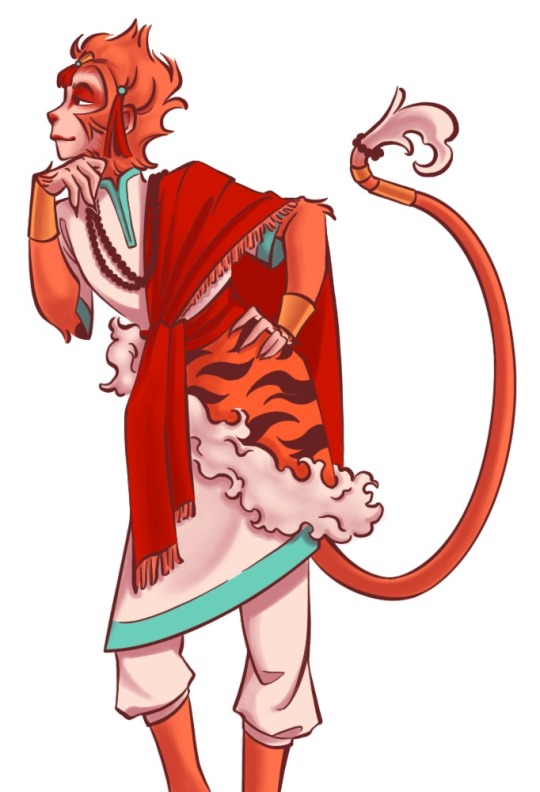

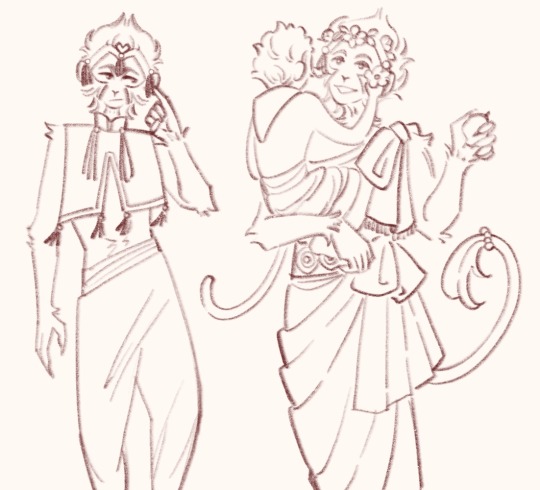
Qitian dasheng and other outfit concept sketches
#I always find it funny when in every iteration wukong is the only one to ever get outfit changes#he ran the fashion department pockets THROUGH#every season china’s Madonna gets a new dress cuz he’s the people’s prettiest little princess#jelly didn’t do a good enough job talking me out of that uglyass qtds design so you guys get to see it#I was going for a more empress dowager look to be unique but it doesn’t really suit him I think lol ^^#back to the drawing board#but I really do like that handsome monkey king sketch#the one with the small monkey in his arms#I like to think he’s actually very motherly to his children subjects <:3#that’s mother#I’m also trying my hand at giving him a more Indian outfit since that’s where they’re going -w-#not really satisfied with any of em lol#the crop top sketch is maybe him directly after getting out of the mountain and being petulant about the band#the tassels STAY ON#digital art#my art#jttw sun wukong#journey to the west#sun wukong#jttw fanart#monkey king#anyways lemme know what y’all think#I actually wanna hear other opinions on this :P#also if you couldn’t tell I’m obsessed with cloud collars at the moment#☁️ 🌺 🦢 ✨
295 notes
·
View notes
Text








Shuanglin Temple 双林寺 is a 6th century Buddhist temple in Shanxi province, China.
It’s a UNESCO World Heritage site, and is protected by the state administration.
The temple was featured in the 2024 game “Black Myth: Wukong”
#china#chinese architecture#chinese#🇨🇳#northern China#chinese heritage#han chinese#Buddhism#temples#chinese buddhism#Buddhist temple#chinese temple#Buddha#sun wukong#black myth wukong#Shanxi#northern qi dynasty#northern qi#journey to the West#jttw#east asia
185 notes
·
View notes
Text

[JTTW OC: 智平] “分桃” The Shared Peach
Originally an act of courtship, Wukong would always share a peach with the Violet Dragon, taking a single bite to ensure it was of high enough standard for him. No matter how many years pass, most mornings spent together begin with the Monkey King passing a peach with a bite taken out of it to his lover.
#did you know that 分桃 is used for gay lovers in china? you now do you’re welcome#as early as a 6th century poem!#instantly assigned it to wukong and zhiping when i deep dived into poetry a few years back#he also calls zhiping 分桃 because he’s the peach that wukong takes a bite out of the most#jttw#jttw oc#journey to the west#black myth wukong#sun wukong#sun wukong x oc#sun wukong x reader#this is a frame from the chap2 stop motion animation btw!#used my fave digital brushes for this one#nice n textured
337 notes
·
View notes
Note
Hello there! I recently discovered your blog and it's really wonderful resource. I have a question and maybe you would be able to answer. From what I know the mourning garments are white, and I've seen some in movies or dramas. But I also saw many hanfu or hanfu-like costumes in dramas that predominately use white as a color for characters. So I am a bit confused, if what is considered mourning garment is much different (in style or in cut)? or the white clothes in dramas are just something modern and for aesthetics? I hope I'm making sense here.. Anyways, cheers and thanks in advance!
Unf, such amazing questions, I love it ❤️❤️
I'm going to answer this one very carefully because I don't want to get screamed at for "gatekeeping" 😆 Right off the bat I'm going to put a disclaimer:
Whatever show you enjoy, whichever actor/actress you like, you do you and have a good time. What I'm going to write is ONLY some trends in Chinese TV/movies over the past few decades, I'm not saying any show isn't "good", please don't hate me.
You're absolutely correct that historically, Chinese mourning clothes are white, but not just white, the material is also important. The actual term for mourning is "披麻戴孝" so if we break the words down:
披 (pi) = to wear on the body (like a cape) 麻 (ma) = hemp (fabric) 戴 (dai) = to wear, to hold, to have 孝 (xiao) = filial piety, show honour and love towards one's parents
So it's wearing white hemp and some sort of white fabric on the head to express one's respect for an elder. Mourning wear is only for those who are older than you (ex. parents, grandparents, older siblings, etc.), of a higher rank, or in some cases your superior (ex. solders in a battalion wearing mourning clothes when their captain passes).
I'll use some screenshots from the 1994 version of Romance of the Three Kingdoms as an example:

Pic 1-3: The emperor has passed away in this situation so everyone is in full mourning attire. His court (pic 1), his concubine (pic 2), his kid (pic 3). If you enlarge the image, you'll see the material they're wearing is quite rough-looking (best seen in pic 3, the other images' resolution aren't great).
Pic 4-6: In this funeral, the Wu Kingdom's Commander of the naval forces has passed away, so almost everyone is in full mourning because that's a very high rank.
Pic 5: You'll see the man on the right isn't in mourning because he's head of the Wu Kingdom, so his rank is higher than the Commander, therefore he doesn't wear mourning clothes.
Pic 6: This man is a visitor and frenemy of the Commander. He's coming from the Shu (Han) Kingdom and because they're not from the same Kingdom, there's no consideration of whose rank is higher or lower. Therefore, he's only worn a strip of white cloth over his hair out of respect (he technically doesn't even need to wear that). Now, obviously, even though he's not required to wear white hemp mourning clothes, it's not a good idea to show up in flashing pink or electric orange (very disrespectful), so he's gone with a soft, pale blue
Pic 7: In this image, a distant relative of the leader of the Shu (Han) Kingdom has passed away (at this point in the show the Kingdom hadn't been established, so he's only the head of a province). This particular relative is younger than everyone present, so; a) he's not ranked above them b) he's not older than them
Therefore, none of them are in full mourning, but they've tied a white cloth to their belt to express respect.
The man in blue, on the right, with the black hat is a visitor from the Wu Kingdom, so much like in Pic 6 he's coming to pay respect to someone not from his Kingdom (doesn't matter the rank) and not his senior) so he's not in mourning clothes (he doesn't even have a white cloth at his belt when he turns around).
So yes, white is traditionally a mourning colour but not all white coloured clothing is for mourning. If you're wearing a white silk robe with embroideries and designs, that's not considered mourning clothes.
Now, having said that, traditionally people still tried to stay away from full on, completely white outfits from head to toe. It's just not a lucky colour to wear. A jacket that's white, or a skirt that's white with a coloured border or some colourful accessories, not a big deal, but if you're going full white in everything...just, no, lol.
As for the Chinese period dramas/movies of today...that's a really deep well to dive through. I'll try to summarize it here and do more detailed posts later on.
TV dramas/movies are never 100% historically accurate, I'm sure everyone knows this, and we don't expect them to be. But for the Chinese entertainment industry it's been becoming less and less accurate in the last 20-25 yrs or so. In terms of clothing/make up/hair/set design/aesthetics in general, there's debate on why these changes have occurred (some say video games, some say foreign aesthetic influence, etc.) but the final result is a LOT of the costumes you see in period dramas today are very, very not historically accurate or even fitting to what is considered "traditional" Chinese aesthetics.
There's a LOT of these "Xianxia" shows going around, stories about immortals and "Gods", "xian/ 仙". I guess the character designers today feel that white somehow makes the characters feel more "immortal", more other-worldly, an imported aesthetic mainly from the West where "white" has been associated with "purity". There's actually growing push-back from the Chinese audience inside China against the character designs in recent years because people are beginning to feel like we're losing OUR aesthetic, these designs aren't what OUR Gods and immortals traditionally looked like. Here's a comparison:

On the left we have some shows and movies from the 80s and 90s, on the right we have more recent shows.
I'll be honest...some of the clothes on the right I barely consider "Hanfu". That's not to say they're not pretty, but the Hanfu influence in them is so small at some point I start thinking, "You're essentially wearing a large-sleeved dress...". In addition to the clothes, there's the hair, the makeup, even the buildings...they're...kind of East Asian styled but not really? I can't even say they're Chinese-styled because it's so generically East Asian some of these set designs.
Traditional Chinese aesthetics favoured bold colours, and the more power and wealth you had the larger the hair styles for women, with rich, beautiful accessories. Gardens and buildings are not minimalistic at all (that leans more Japanese style), rooms are not large and empty, even in large buildings each individual room are sectioned to be fairly small. There's a running joke on Bilibili (Chinese youtube) that the Heavens have gone bankrupt these days because the costumes, the hair, and buildings look so...bare xDD
Some audiences will say these shows are fiction anyway, not set in any particular time or country but...I mean, clearly they're not writing about a Western immortal or an African God, these stories are set in the frame of Chinese characters.
In any case, basically what I'm saying is, take the Hanfu you see in dramas/movies with a grain of salt. Sometimes with a whole bag of salt. It's absolutely no problem to like them, enjoy them, cosplay them, buy them, but don't link them to anything with history unless you do some research.
And again, not saying any show is good or bad, enjoy whatever you want, this is only an opinion regarding trends in Chinese period dramas/movies. If you'd like to see what a traditional Chinese image of "Heaven" and immortals look like, here's a video from the 1986 version of Journey to the West. This is a show I would say over 80% of Chinese people have seen, most of us watched it as kids. Many, many people think it recreates the image most Chinese people have of what our "Heaven" looks like:
Src: 嗑学家与挑剔学家 【86版西游记演出了中国传统神仙该有的样子】 https://www.bilibili.com/video/BV1DV4y1g73N/
#hanfu#汉服#china#中国#chinese hanfu#culture#history#fashion#clothing#historical clothing#披麻戴孝#86西游记#西游记#天庭破产了#买不起好衣服了哈哈哈#mourning clothes#journey to the west#chinese period dramas#守着金山要饭吃
162 notes
·
View notes
Text
Weird isekai idea that I had that I just wanted to realise into the wild.
Ok so you know how there are multiple stories out there about reader getting transported into the world of journey to the west and then ending up tagging along as the pilgrims make their way west. Here's the thing most of the time these story's take place once the group has already been assembled or the reader ends up meeting Tripitaka first.
So here's the thought what if reader meets Wukong before the group has a chance to get together. Let me explain.
So imagine reader has just arrived in a strange new world and they have absolutely no clue where they are or how they got there and are freaking out really badly. So they start calling out to see if there is anyone nearby that can help them and after a good few minutes of wandering around and shouting for help they suddenly get a reply. Relived they rush towards the voice, only to find that the person that was calling to them wasn't a person but a monkey that looks to be trapped within the rock of a mountain. And it only takes them a second to realise that this isn't just any monkey but thee monkey, the monkey king, Sun Wukong himself and somehow they've been transported into the story of journey to the west. Their internal crisis soon gets interrupted as Wukong starts asking if they wouldn't mind helping him out with his situation. Knowing the story not to mention what Wukong's capable of they immediately disagree much to Wukong's outrage. At Wukongs outburst they go to leave but that’s when they realise that they still have no clue where they are and what's worse no idea who could help them except for maybe Tripitaka so they resolve to wait for him much to Wukong confusion. Realising that it might not be a good idea to tell him that they are not exactly from this world they stick with the hopelessly lost excuse. which Wukong responds with that he would be happy to help them out if they let him out which is an obvious no so things quickly devolve into a stale mate.
Days go by and they end up talking a lot, with Wukong casually trying to convince them to take off the seal every now and then and them always refusing. But as the days go by the more anxious and worried reader gets after all they have no idea at what point in the story they are and it could very well be a hundred year before Tripitaka will eventually show up. Food and shelter are also a worry as they've managed to get by due to it being summer and there is plenty to forage and a small cave nearby that they've been using for shelter but they know it won't last forever. but most of all they really, really want to go home they miss their family their friends they miss their life. More time goes by and day by day reader and Wukong bond even more to the point where the monkey king has actually grow quite fond of them and cares quite a lot to the point that he starts helping them out in what little ways he can. He even stops constantly trying to get them to remove the seal on the mountain only occasionally asking every now and then and its usually only after he see them struggling, instead he's taking the time to ask them about themselves and find out more about them and in return he tell them about himself usually stories of his glory days. eventually they come clean about the fact that they are not from this world and how they have no idea how they got here or how to get home, breaking down a bit as Wukong resolves to help in any way he can. Then one day it happens completely unprompted reader suddenly get up and start walking away at first Wukong doesn't think anything of it as they often leave to look for food and other such things but as the hours go by and they've yet to come back Wukong starts to worry think that something bad might have happened to them before he gets the horrible thought that they might have just finally got sick of waiting and left him. Stewing in his thought the monkey king slowly growing more and more enrage and heartbroken at the potential betrayal. when suddenly he can feel it, he can feel the mountain shift and he realise what they have done. It's after another few hours pass that he hears them running down the mountain catching a quick sight of them as they run past him. it doesn't take him long to realise that they are getting a safe distance away and he waits a few more hours before he finally breaks free. Meanwhile your despriatly trying to catch your breath as you watch the entire mountain explode chunks of rock flying in all directions and your barely able to make out a reddish orange blur coming towards you before your enveloped in a bone crushing hug.
Thus beings their own journey to find a way to get reader home.
I dunno I just really like the idea of Guanyin or Tripitaka turning up and Wukong not being there and all of haven freaking out because the monkey king is on the loose and no one has any idea where he is.
#journey to the west#jttw#sun wukong#monkey king#sun wukong x reader#monkey king x reader#my writing#isekai au#not gonna lie part of me would really like to turns this into a fic#but i have way too many wip as is#tripitaka wondering where his first disciple went lol#wukong and reader just causing havoc across china#x reader#reader insert
320 notes
·
View notes
Text

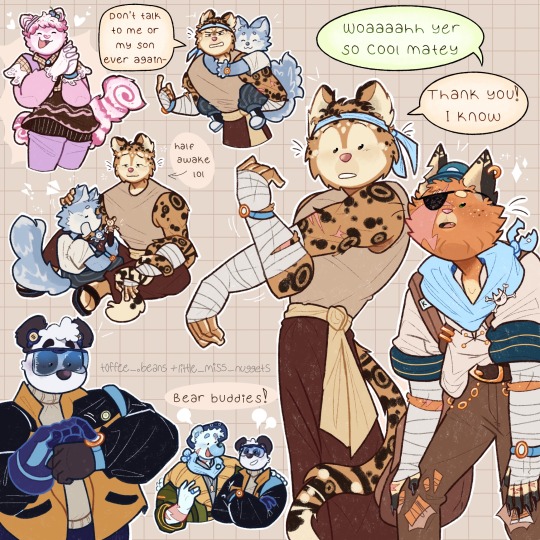

So how about that new octonauts show huh
#octonauts#octonauts journey to China#WOOO NEW CHARACTERS!! idk. how to tag them cuz i dont rly know their names lol#captain barnacles#kwazii octonauts#octonauts fanart#calico jack#octonauts calico jack#I haven’t seen all the new episodes yet but it’s cute so far!!#Me and nugs like the panda:] skrunkly#also love the leopard guy. xoxo heart eyes at him
1K notes
·
View notes
Text
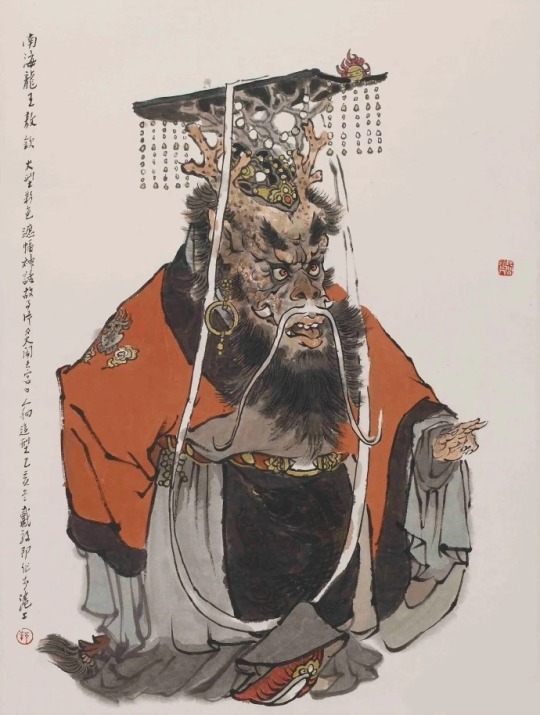
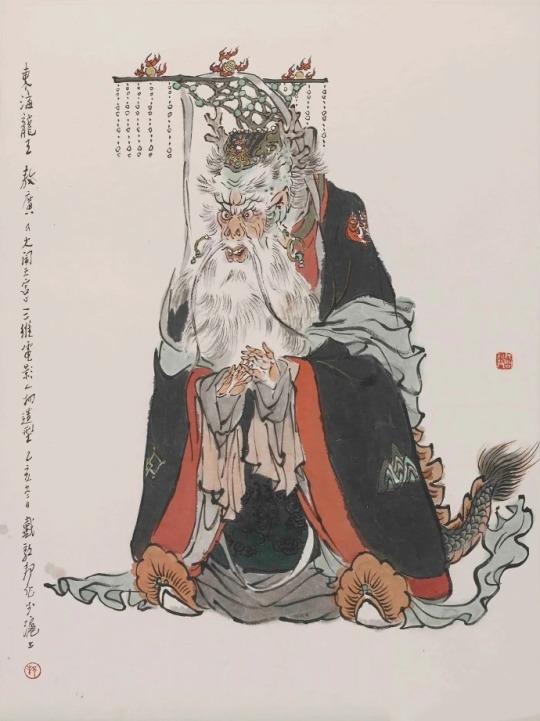
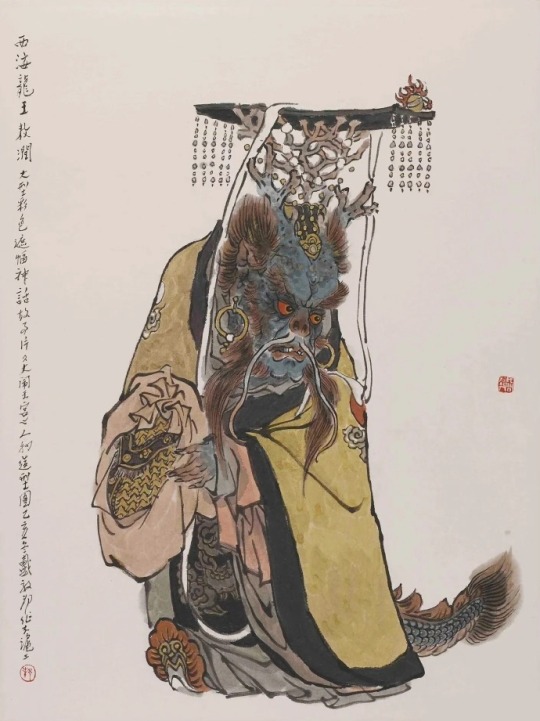
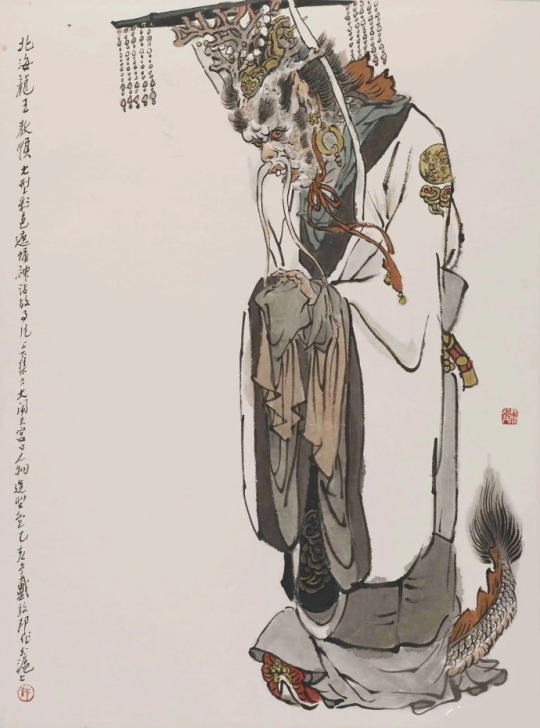
Dragon Kings of the Four Seas
Renowned Shanghai painter’s Dai Dunbang (戴敦邦) 20th century illustration for the Chinese Ming dynasty classic “Journey to the West” (《西遊記》) attributed to Wu Cheng'en (吳承恩).
#chinese art#ancient china#chinese culture#chinese painting#chinese calligraphy#chinese ink#ink painting#watercolor#dragon#dragon art#mythical creatures#chinese mythology#mythological creatures#journey to the west#chinese literature#dragon king#Dai Dunbang#西遊記
930 notes
·
View notes
Text

And why she oink?
#octonauts#mooshie art#Aiyuguli#octonauts journey to china#rip six year old me you would’ve loved her
105 notes
·
View notes
Text












chinese fashion based on journey to the west on xhs
white skeleton spirit or white-bone demon,black fox spirit,black spider spirit,blood spider spirit,lady gao cuilan (forced by Zhu Bajie to be his wife and this one is disguised by sun wukong)
191 notes
·
View notes
Text
some things I wish to highlight from this adorable JtC Clip
youtube
DASHI AND TWEAK VIDEO GAME BESTIES. I KNEW IT. I KNEW IT WOULD BE CANON ONE DAY
the custom video game on the TV has my heart 🥹 officially headcanon that Dashi coded it for both of them
Tweak getting pissed off that Dashi beat her. another skill to add to Dashi's repertoire ig
THE WAY THEY'RE SITTING ALSO HAS MY HEART idk why
the looks of utter concentration on their faces
i love to see them hanging out casually together
I mean I also love seeing them working together (girls in STEM ftw)
but I'm glad we get to see them having some downtime
I knew Dashi would be a video game girl. I KNEW IT.
also
Professor Inkling, the table tennis icon
like look at him
book in one tentacle, cup of tea in another, single-handedly absolutely kicking Kwazii's ginger arse
Boss Mode Inkling pt.2? quite possibly
#octonauts#octonauts journey to china#octonauts above and beyond#octonauts dashi#octonauts tweak#octonauts kwazii#octonauts inkling#kwazii#dashi#tweak octonauts#professor inkling#twashi my video game besties#video game lesbians? perhaps#boss mode inkling is now a thing i declare it so#this has made my day#twashi vs boss mode inkling WHEN#Youtube
60 notes
·
View notes
Text
Pop Culture Chinese Mythology? : The Heaven Haters Boy Band
I first introduced the Heaven Haters boy band in my Erlang Shen post, but it’s a recent meme that describes Ne Zha, Sun Wukong and Erlang Shen as the 反天庭三人组, or the Anti-Heavenly Court Trio. A little like the 3 Musketeers.

I already included this art in a different post but it just goes so hard.
Artist 万葉皆秋 on Xiaohongshu and Douyin
I’m sure you can learn about Sun Wukong from more qualified people than me, but some shameless self-promo:
My Ne Zha post
My Erlang Shen post
My Investiture of the Gods post
I recommend either reading all 3 of these, or at least the first two, or doing some research into these myths before you can understand the power of the Heaven Haters boy band.
Keep in mind the Heaven Haters boy band is mostly headcanons and memes. While these three characters do all rebel against heaven, they all ultimately concede defeat to ultimate authority: Wukong gets properly humbled by the Buddha and the monk Tangsen (Read JTTW to know who Tangsen is), Erlang Shen and Ne Zha eventually become the Heavenly Court’s special ops squad.
Heaven Haters boy band is still funny though, and they genuinely do all hold resentment for heaven.
I’ll make clear how and why the various members of the Heaven Haters boy band rebel against heaven.
Sun Wukong:
This is fairly obvious. His most famous story is literally called Havoc in Heaven 大闹天宫 (or more literally, Tantrum in Heaven)
He was literally born with Rebellion as his middle name. First thing he does upon gaining power is rampaging his entire way through the East China Sea Dragon King’s entire palace for fancy weapons. (This, by the way, is Ao Guang, Ao Bing’s dad.)
Then he goes and smashes up the heavenly palace. Then he literally FIGHTS HIS WAY THROUGH HELL and erases his name off the list of the dead. Soloed 100,000 of the Heavenly Court’s soldiers and won (actually I don't remember if this was in the original JTTW or if it's a plot point from a recent movie adaptation, but either way it's a pretty well-known part of his story).
Erlang Shen:
This seems subtler since he works for the Heavenly Court, and his uncle is the Jade Emperor, the head honcho. However, he still disobeyed the direct Heavenly Mandate to trap his mom under a mountain, and he split the mountain in half to save her.
Erlang is more of the cold, calculated type- if you offend him or try to fuck him over, he’ll ruin your life, but otherwise he couldn’t be bothered. In fact, even though he helps the Heavenly Court, he only does so for big opponents like Wukong- day-to-day tasks that his position requires, he totally ignores.
His uncle struggles to control him, and has resigned himself to just letting Erlang Shen do whatever the fuck he wants.
Ne Zha:
Although Ne Zha isn’t as strong as the other two, he’s still one of the strongest in the entire Heavenly Court. He’s the type to throw hands first and talk later. He’s more obedient to the Heavenly Court than Erlang or Wukong, but he’s probably actually done the worst thing out of the three of them: try to commit patricide.
This is a HUGE no-no in Chinese culture, which prioritises filial piety over almost everything else. Erlang Shen splitting the mountain in half to save his mother (and directly disobeying Heaven) isn’t as bad as Ne Zha trying to kill his dad.
I’m not going to blame him, since Li Jing is a bit of a dick, but if Li Jing didn’t have that powerful pagoda the Buddha gave him, Ne Zha would set him on fire in a heartbeat.
In battle, Erlang is what you would call a homing missile, Wukong is a tactical nuke, and Ne Zha is a bunch of cluster bombs. Erlang is precise and deadly, Wukong is… Wukong, and Ne Zha does not discriminate in who he wants to beat up. Surprisingly, out of these three, even though Wukong is the one famous for throwing a huge tantrum, he’s probably the most reasonable and gentle one.
Let me put it this way: would you rather deal with a murderous iPad kid on (actually) flaming Hot Wheels roller skates who punches first and asks questions later, a sadistic royal warrior who can split you open from inside (NOT THAT WAY, get your heads out of the gutter),
Or a feral monkey that you can placate just by calling him a bunch of fancy nicknames?
I'll just say that neither Ne Zha nor Erlang Shen would be tricked into putting on a cursed set of clothes to control them. I'd MUCH rather deal with Wukong as an enemy. Worst case scenario I die painfully anyway, so I'd like to at least have a chance to pull out the fancy nicknames and appease him.
See, this is the reason they sent Wukong to go on the Journey to the West and not Ne Zha or Erlang. I don’t think they would’ve made it two steps on the way before the other two beat Tangsen to death just for looking at them the wrong way.
Also another thing that’s funny is their names technically line up.
Sun Wukong’s title: Qitian Dasheng 齐天大圣 Great Sage Equal to Heaven
Erlang Shen’s title: 二郎神 Godly Second Son
Ne Zha’s title: 哪吒三太子 Ne Zha the Third Prince
So… 大圣二郎三太子... Great Sage, Second Son, Third Prince.
This is funny because this is the reverse order of their ages. Ne Zha is the oldest, Erlang is the second oldest, and Wukong is the youngest.
Also funny is that Erlang and Wukong are the strongest and Ne Zha is weaker despite being younger. Not much you can do against Monkey King hacks.
It’s debatable who’s stronger between Wukong and Erlang. Technically it’s Erlang- he’s beaten Wukong before, albeit with help and while Wukong was trying to protect others.
Between the three strongest mythological characters (in popular culture, there are others stronger), their stats are:
11 eyes
10 arms
0 parents
10 billion various side characters killed
If you recall, Wukong was born out of a rock. Ne Zha’s mom is probably dead by now. He also already has “returned his flesh and bones to his parents” by cutting himself apart and committing suicide for his dad, so technically he and Li Jing aren’t father and son anymore. I actually don’t know if Erlang’s mom is still alive but his dad is definitely dead.
There’s a funny saying in Chinese: 一块石头两斤藕,三只眼睛栓条狗
One rock, two lotus roots, three eyes and a dog.
That’s all it takes to make the Heavenly Court shiver in fear LMAO. Basically the equivalent of a toddler, a monkey and a Californian dog dad.
In essence, I stan the Heaven Haters boy band more than any other K-pop group, sorry Stray Kids. I'm not going to lie though, Erlang Shen is definitely a smash. Ne Zha... IDK, not exactly my type (unless its the recent Jiaozi movie Ne Zha). Wukong is a monkey but I can definitely see the appeal for some people I guess.
Keep in mind for the Wukong simps that in most adaptations, since he is... well, a monkey, he speaks with the Chinese equivalent of a heavy Cockney accent. Do with that what you will.
#ne zha#sun wukong#journey to the west#chinese mythology#chinese literature#chinese culture#chinese history#china#mythology and folklore#ancient china#erlang shen#nezha 2019#nezha 2025
51 notes
·
View notes
Text

#art#tumblr radar#games#radar#game#china#black myth wukong#monkey king#the destined one#journey to the west#jttw#jttw sun wukong#sun wukong#sun wokung
69 notes
·
View notes
Note
Do you have a favourite c-drama, either historical, modern or fantasy? I really enjoyed watching Everlasting Longing
I absolutely have a favourite, along with 3 other that come really close 😃 These 4 shows I've watched for almost 30 years now and I still keep re-watching them because of how amazing they are.
a) 1994 Romance of the Three Kingdoms (三国演义) b) 1986 Journey to the West (西游记) c) 1987 Dream of the Red Chamber (红楼梦) d) 1998 Water Margins (水浒传)
These 4 series were based off of the classical novels of the same names. They were produced by CCTV, the central broadcasting network in China, so we call them 央视版 (central broadcast version) because there are many other adaptations.

Romance of the Three Kingdoms, out of these 4 series this one is my ABSOLUTE favourite. Not only for Chinese drama, this is my favourite show historical, modern, Chinese, English, the top spot in my heart.
This story is set in the Three Kingdoms period of Chinese history. Out of all 4 classics, this one is the most historical, but the story DOES contain many fictional aspects. Many people say it's 70/30 (70% based on history, 30% made up/tweaked from history). The characters themselves ARE all real in history, and the general direction of the story follows history as well.
Near the end of the Han Dynasty, local warlords started gaining power, eventually splitting the country into 3 Kingdoms. That's pretty much the basis of the story. It goes into strategies used in warfare, psychology of using strategies, famous battles, etc. People also use it to discuss some philosophical questions like, honor, right vs wrong (kill an innocent person to calm an entire army, is that justified? etc.), what is acceptable as a leader, being faithful to your country, not giving up, etc.
I've watched this series no less than 20 times over the past 30 years and every time I still laugh and cry. I also know enough about the background when they were filming to know how difficult it was. The series is 84 eps long, they filmed in 5 groups for 3 years (so basically all 5 groups were filming at the same time to save time), even utilizing the military for some of the larger battles. Main character roles were paid 250 yuan/episode (about $34 USD today), which was fairly good for salary back then but nowhere near the outrageous amounts actors get today compared to average worker. The first few months before filming all actors went through training, horseback riding, fighting, going over the novel with experts, learning etiquette and mannerisms, etc.
This series also has my favourite historical figures, Emperor Liubei and his Prime Minister Zhuge Liang. After researching the actual history of this period, these two are my top historical Emperor/advisor pair. An Emperor who trusted his Prime Minister with his Kingdom, and a Prime Minister who fought to the last breath to fulfill the dream they had together T___T 为什么我的鱼水君臣要 BE...😭😭😭
If you're interested in watching this series, @hanchaozhilang is doing English subs for the whole series
Putting up 2 MVs for them here (combined into 1 video), 我家昭烈帝和武侯有排面!!
Srcs: 一知半解书 【悬溺一响,诸葛亮登场】 https://www.bilibili.com/video/BV1nP411W7tA/
博文儿吖 【刘备|正史燃向】翻译翻译什么叫昭烈! https://www.bilibili.com/video/BV14r4y1m7rs/
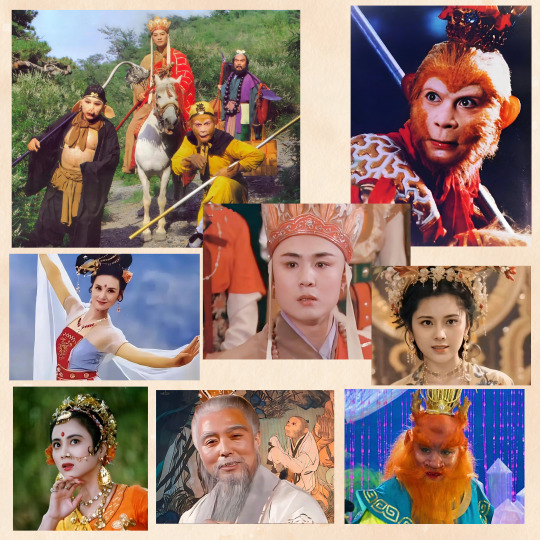
Journey to the West is based off of a true event in history, during the Tang Dynasty. A monk went on a journey from Chang'an (now Xi'an) to India for Buddhist scriptures. I'm not too familiar with the actual history, but I can imagine back then it would've been an incredibly difficult journey to make.
The novel took that journey and expanded it. They wrote in 3 disciples for the monk (technically 4...the horse who's the son of one of the Dragon Kings is also one), and put 81 "tests" along the way. The monk and his disciples had to overcome these attempts to thwart their journey to finally reach their goal.
The main character of this series isn't actually the monk but his eldest disciple, the Monkey King (top right). The Monkey King (named Sun Wukong) was birthed from a rock, and learned skills like how to transform into various objects, how to fly, etc. At one point he trashed the Jade Emperor (Emperor of the Heavens) palace and was sentenced by Buddha to be trapped under a mountain, but was tasked to assist the monk on his journey 500 years later.
When they filmed this series they were desperately short on funding, only had 1 video camera to use xD Every single main actor took on several roles (some of the smaller monster roles, once all the makeup was on you couldn't tell anyway). The actor who played the Monkey King, Liu Xiao Ling Tong, he came from a family of Peking Opera performers who specialized in the Monkey King role, so he excelled in it.

The novel Dream of the Red Chamber is originally called Story of the Stone (石头记). It centres around several large, rich, powerful families interconnected through marriage, with members serving in the court and one of the daughters even being a concubine to the Emperor. Although the story doesn't specify a dynasty, most people speculate it's likely set in Ming (the author was from the Qing Dynasty).
There are numerous storylines throughout the story, but the main one is between a young man, Baoyu, and his cousin, Daiyu (top left). This novel is incredibly complicated, with an entire profession dedicated to studying just this book (called "Redology" 红学). It can be viewed as telling the rise and fall of a family, but can also be viewed to describe a society and the rise and fall of dynasties. There are many, many characters in this book all with different story arcs. When I was a child, watching this show was just pretty clothes and hair, but as I grew, every time I re-watched the show I found reflections of life in this story. Family relationships, friendships, colleagues, bosses, this story touches on all of them, so whatever age you read this book/watch this show there's things to think about.
Many of the actors for this show were not actors by profession, literally plucked from the crowd. For two years prior to filming, all of them lived together, learning the script, reading the novel, going over it with experts, learning mannerisms, how to write calligraphy, poetry, etc. Their roles weren't immediately set, so during those two years they all tried out different roles, memorized lines, basically like living in a giant dormitory together, so once filming did start their "acting" was very natural.

Water Margins is set in the Song Dynasty. This story, to me, is darker than the other 3. The story depicts a court that is very corrupt and unjust, which forces a lot of otherwise good people to resort to criminal activity. Over 100 of them gather on a mountain in the middle of a lake, called Liangshan, where they essentially become a gang.
The traditional view of them tended to be kind of like Robinhood, raiding local cities and distributing the wealth to the people but if you actually read the book it's darker. Before joining the group, some of them would kidnap women and **** them, or one person had a restaurant where she murdered customers and made them into meat buns O.O;; So...yeah, dark stuff.
But anyway, the story goes into how this group take on the courts, lots of fighting, lots of bloodshed, the ending's really tragic T_T
#中国#china#chinese history#c-dramas#dream of the red chamber#journey to the west#romance of the three kingdoms#water margins#电视剧#古装电视剧#三国演义#西游记#红楼梦#水浒传#央视#央三#86西游#87红楼#98水浒#怀念老剧#前几天看到丞相在B站拜年开心哈哈
112 notes
·
View notes